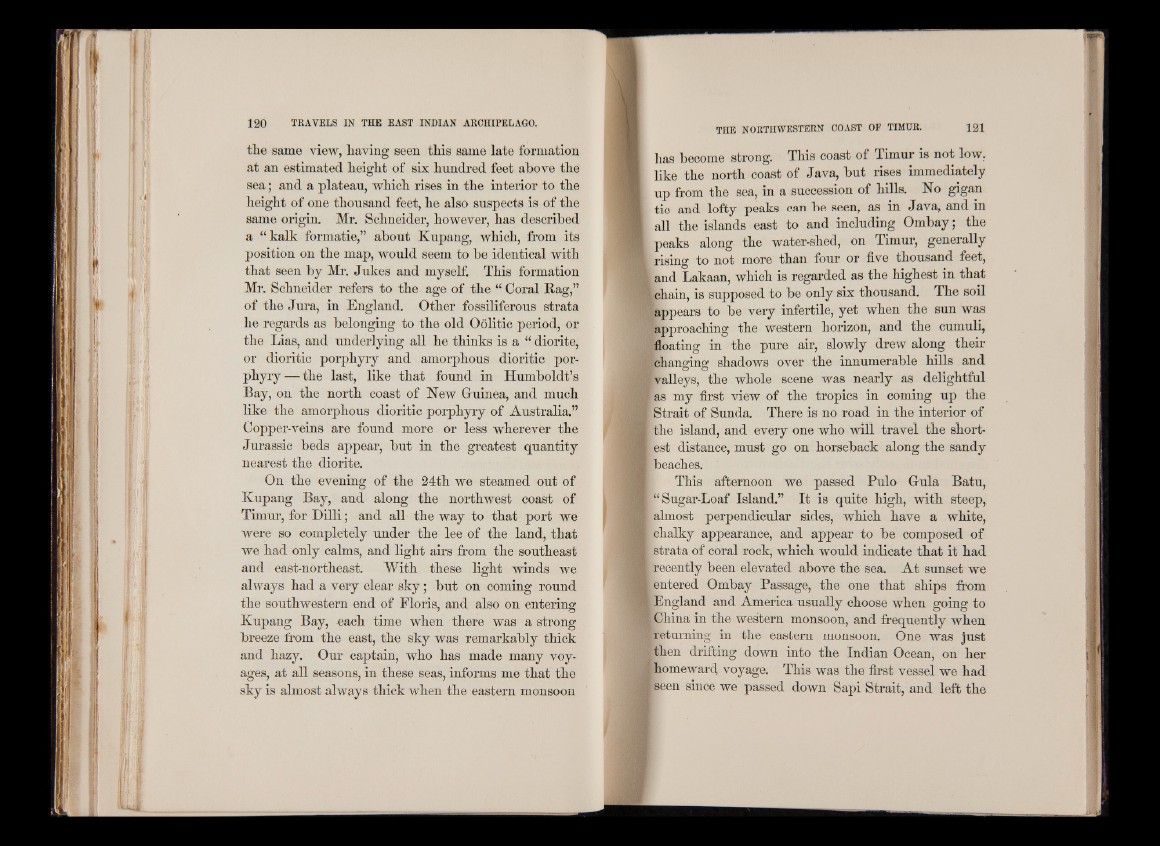
the same view, having seen this same late formation
at an estimated height of six hundred feet above the
sea; and a plateau, which rises in the interior to the
height of one thousand feet, he also suspects is of the
same origin. Mr. Schneider, however, has described
a “ kalk formatie,” about Kupang, which, from its
position on the map, would seem to be identical with
that seen by Mr. Jukes and myself. This formation
Mr. Schneider refers to the ag;e of the fjj Coral Rase,” O O ’
of the Jura, in England. Other fossiliferous strata
he regards as belonging to the old Oolitic period, or
the Lias, and underlying all he thinks is a “ diorite,
or dioritic porphyry and amorphous dioritic porphyry—
the last, like that found in Humboldt’s
Bay, on the north coast of Hew Guinea, and much
like the amorphous dioritic porphyry of Australia.”
Copper-veins are found more or less wherever the
Jurassic beds appear, but in the greatest quantity
nearest the diorite.
On the evening of the 24th we steamed out of
Kupang Bay, and along the northwest coast of
Timur, for Dilli; and all the way to that port we
were so completely under the lee of the land, that
we had only calms, and light airs from the southeast
and east-northeast. With these light winds we
always had a very clear sk y ; but on coming round
the southwestern end of Floris, and also on entering
Kupang Bay, each time when there was a strong
breeze from the east, the sky was remarkably thick
and hazy. Our captain, who has made many voyages,
at all seasons, in these seas, informs me that the
sky is almost always thick when the eastern monsoon
lias become strong. This coast of Timur is not low,
like the north coast of Java, but rises immediately
up from the sea, in a succession of hills. Ho gigan
tic and lofty peaks can be seen, as in Java, and in
all the islands east to and including Ombay; the
peaks along the water-shed, on Timur, generally
I rising to not more than four or five thousand feet,
I and Tjfl.ka.an , which is regarded as the highest in that
I chain, is supposed to be only six thousand. The soil
appears to be very infertile, yet when the sun was
approaching the western horizon, and the cumuli,
floating in the pure air, slowly drew along their
fchanging shadows over the innumerable hills and
I valleys, the whole scene was nearly as delightful
las my first view of the tropics in coming up the
[ Strait of Sunda. There is no road in the interior of
the island, and every one who will travel the short-
jest distance, must go on horseback along the sandy
beaches.
This afternoon we passed Pulo Gula Batu,
I “ Sugar-Loaf Island.” It is quite high, with steep,
I almost perpendicular sides, which have a white,
I chalky appearance, and appear to be composed of
strata of coral rock, which would indicate that it had
(recently been elevated above the sea. At sunset we
¡ entered Ombay Passage, the one that ships from
(England and America usually choose when going to
I China in the western monsoon, and frequently when
■returning in the eastern monsoon. One was just
¡then drifting down into the Indian Ocean, on her
I homeward voyage. This was the first vessel we had
■seen since we passed down Sapi Strait, and left the